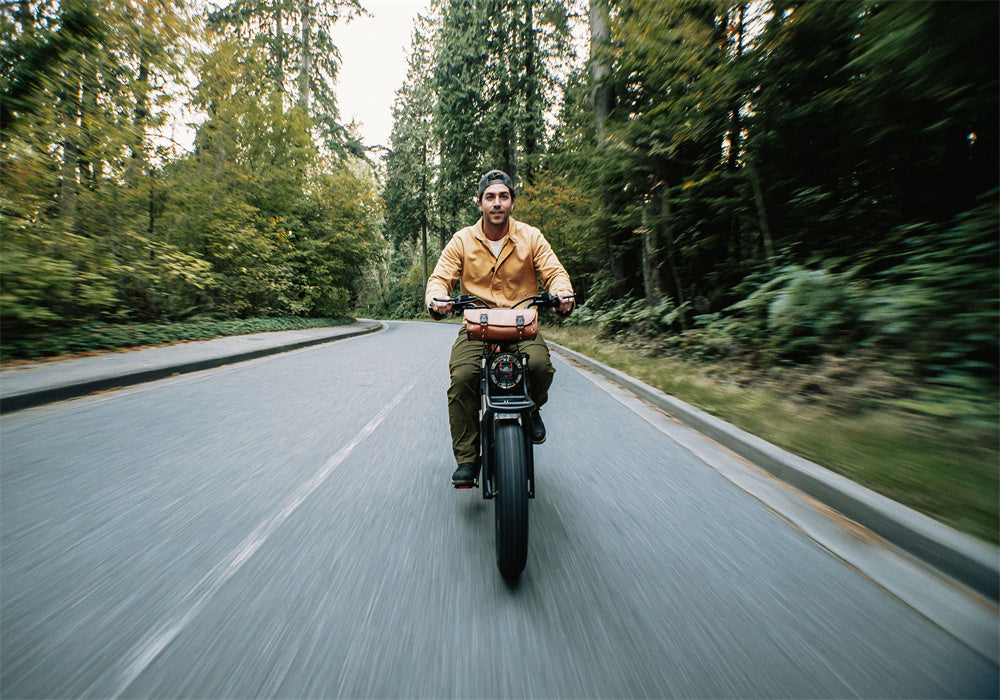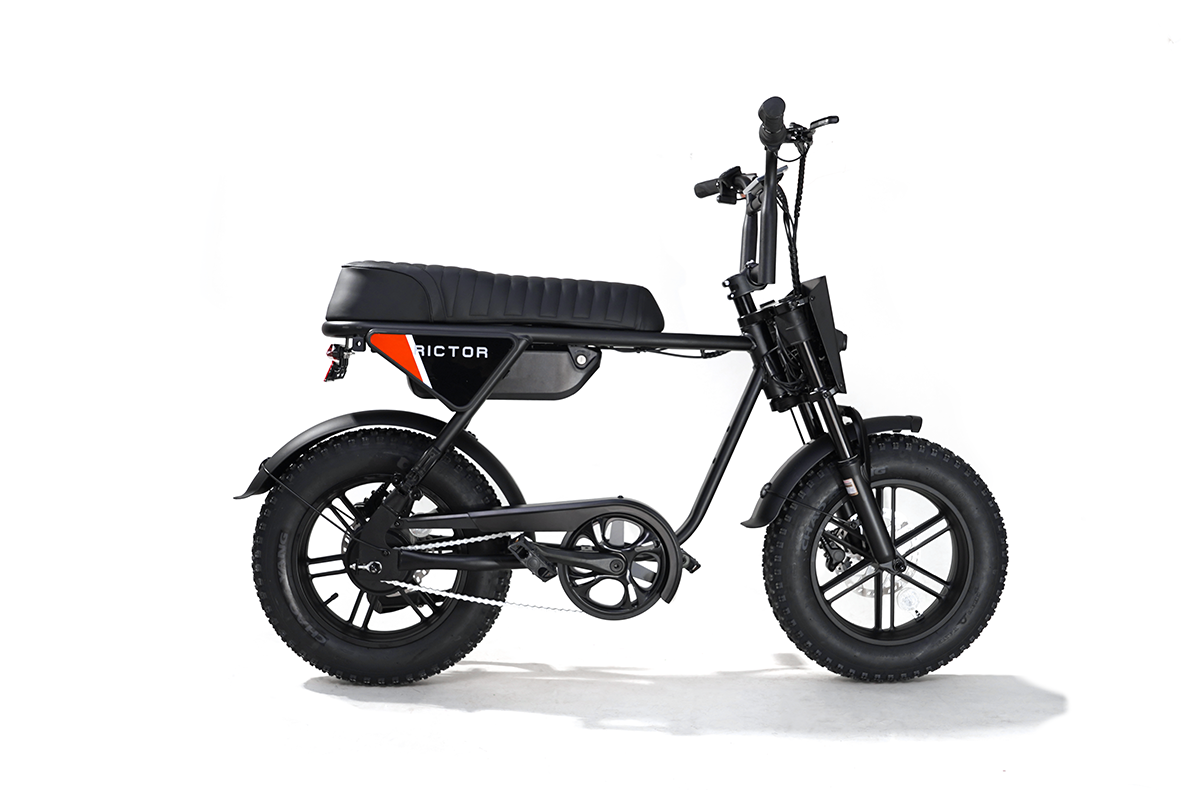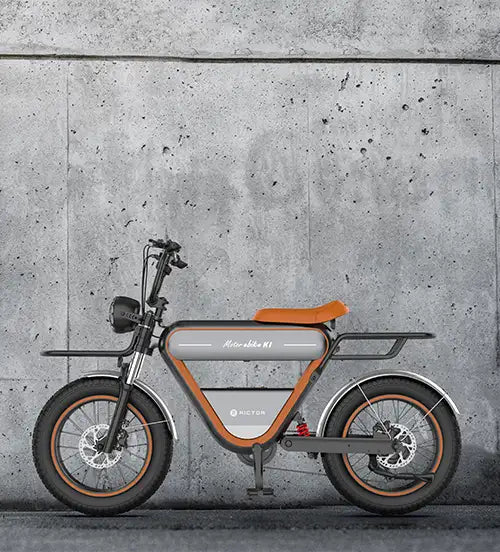
Everything You Need to Know About Your Ebike Frame
E-bike frame is a critical component that defines your electric bike's performance, comfort, and overall ride experience. More than just a structural element, the E-bike frame is engineered to uniquely support the demands of electric assistance, integrating power and design seamlessly.The quality of an e-bike frame truly dictates your e-bike's overall performance. In the sections that follow, we will directly explore every essential aspect you need to know about e-bike frame.
E-bike Frame Types
Step-Through Frames: Accessibility and Comfort
Step-through ebike frames have a low or absent top tube, allowing easy mounting and dismounting.
-
Pros: Ideal for riders with limited mobility, frequent stops, or non-sporty attire. Promotes an upright, comfortable posture. Common for commuters.
-
Cons: Can be less stiff than diamond frames, potentially heavier to compensate. Not typically for high-speed or rough terrain.
-
Typical Applications: Urban commuting, city cruising, errands.
Diamond/Step-Over Frames: Classic Stiffness and Performance
The diamond or step-over ebike frame is the classic design with a high top tube. It's a popular ebike frame choice.
-
Pros: Inherently sturdy and robust, often lightweight with good structural integrity and balanced weight distribution. Offers better speed and handling for varied terrain.
-
Cons: Mounting can be challenging for some.
-
Typical Applications: Longer commutes, fitness riding, e-touring.
SEE ALSO Choosing the Right Electric Bike: Step Thru vs Step Over Frame Design
Folding E-bike Frames: Portability and Convenience
Folding ebike frames feature hinges allowing the bike to collapse into a compact package.
-
Pros: Massive space saving, easy to transport on public transport or in vehicles.
-
Cons: Potentially less stiff than non-folding frames, not for aggressive off-road use. May have compromises in battery capacity or cable routing due to the folding mechanism and can be more expensive.
-
Typical Applications: Urban commuters with limited storage, travelers.
Cargo E-bike Frames: The Heavy Lifters
Cargo ebike frames are built to carry substantial loads like children or groceries.
1. Longtail Cargo Ebikes
Extended rear frame for passengers or cargo.
-
Pros: More agile than front-loaders, good weight distribution.
-
Cons: Slightly lower load limits than some front-loaders.
-
Typical Applications: Family transport, school runs, urban deliveries.
2. Front-Loader (Bakfiets/Long John) Cargo E-bikes
Cargo area between handlebars and front wheel.
-
Pros: Exceptional stability with heavy loads, great child visibility.
-
Cons: Can be less maneuverable with a wider turning radius.
-
Typical Applications: Transporting young children, bulky items, business deliveries.
Cargo E-bike Frame Design Considerations: Frame strength (reinforced aluminum or high-tensile steel) is paramount. Smaller wheels often lower the center of gravity for stability. Powerful hydraulic disc brakes are essential. Careful weight distribution is crucial for loads that can exceed 200 kg.
Mountain E-bike (eMTB) Frames: Conquering Trails
eMTB ebike frames are robust for off-road use, integrating suspension and managing the weight of e-components.
1. Hardtail eMTB Frames
Front suspension fork, rigid rear.
-
Pros: More affordable, lighter, less maintenance than full-suspension. Efficient power transfer for climbing on smoother trails.
-
Cons: Less comfortable and controlled on very rough terrain.
-
Typical Applications: Light to medium trails, XC riding.
2. Full-Suspension (Fully) eMTB Frames
Front and rear suspension.
-
Pros: Superior shock absorption, more comfort and control on rough trails.
-
Cons: Higher price, heavier, more maintenance.
-
Typical Applications: Technical trails, enduro, downhill.
E-bike Frame Materials
The material of an ebike frame influences weight, strength, ride feel, durability, and price. This is especially critical for ebikes due to the added weight of motors and batteries.
Aluminum Alloys: The Versatile Workhorse
Aluminum alloys (like 6061 or 7005) are the most common for ebike frames, offering a balance of performance, durability, and affordability.
-
Pros: Lightweight, helping offset e-component weight. Relatively affordable. Stiff for responsive handling. Good strength-to-weight ratio and corrosion resistance. Hydroforming allows complex tube shapes for integration. Good impact resistance.
-
Cons: Can transmit more road vibrations, leading to a harsher ride. Can fatigue over extended heavy use. Repair is challenging.
-
Ebike Relevance: Excellent value, used across all ebike types. Innovations like advanced hydroforming and improved alloys continue to enhance its appeal. Aluminum ebike frames can be 40-60% cheaper than carbon fiber in 2025.
Carbon Fiber: The Lightweight Champion
Carbon fiber is premium for ultimate lightweight performance, known for an exceptional strength-to-weight ratio.
-
Pros: Remarkably low weight (20-30% lighter than aluminum with superior strength ), improving agility and potentially range. Superior vibration damping (absorbs up to 30% more than aluminum ) for a smoother ride. Allows complex aerodynamic shapes and targeted stiffness.
-
Cons: Most expensive option (40-100% more than aluminum ). More brittle to sharp impacts; repairs are complex and costly.
-
Ebike Relevance: Ideal for performance ebikes (eMTBs, road ebikes) where weight is key. Growing focus on sustainable production.
Steel: Durable and Smooth
Steel (often chromoly) remains relevant for ebike frames when durability and ride comfort are key.
-
Pros: Incredibly strong and durable, capable of decades of use. Natural flexibility absorbs vibrations for a smooth ride. Most easily repairable material. Good value considering longevity.
-
Cons: Significantly heavier than aluminum or carbon fiber. Susceptible to rust if not maintained.
-
Ebike Relevance: Weight is less critical with motor assist, making steel's comfort and durability attractive for commuting, touring, and cargo ebike frames.
Titanium
Titanium offers a unique blend of properties from other materials.
-
Pros: Smooth ride like steel, but considerably lighter (approaching aluminum weight). Exceptional strength, fatigue resistance, and durability ("forever frame"). Excellent natural corrosion resistance. Recyclable.
-
Cons: Very high cost due to material and specialized manufacturing/welding. Repairs are challenging and costly.
-
Ebike Relevance: Gaining popularity in high-end ebikes for riders seeking ultimate lightweight performance, durability, and comfort.
Magnesium Alloys: Emerging Lightweight
Magnesium alloys are newer, noted for light weight and excellent vibration damping.
-
Pros: Even lighter than aluminum (about 30% lighter with similar strength). Superior vibration absorption for a smooth ride. Potentially lower manufacturing costs than carbon fiber.
-
Cons: Highly susceptible to corrosion, requires robust coatings. Softer material, prone to dents. Complex manufacturing. Still rare.
-
Ebike Relevance: Compelling for comfort-oriented ebikes.
| Material | Key Properties (Strength-to-Weight, Stiffness, Vibration Damping, Corrosion Resistance) | Typical Weight | Durability | Repairability | Cost |
| Aluminum Alloy | Good S-W, High Stiffness, Low-Mod Damping, Excellent Corrosion Res. | Medium | Good, can fatigue over time | Challenging, specialized welding | Low-Medium |
| Carbon Fiber | Excellent S-W, Tunable Stiffness, High Damping, Good Corrosion Res. | Very Low | Strong, but brittle to impacts | Complex, specialist, costly | High |
| Steel | Moderate S-W, Moderate Stiffness, Excellent Damping, Prone to Rust | High | Excellent, very long-lasting | Easiest, widely weldable | Low |
| Titanium | Excellent S-W, Mod-High Stiffness, Excellent Damping, Exceptional Corrosion Res. | Low | Exceptional, "forever frame" | Difficult, specialist welding | Very High |
| Magnesium Alloy | Very Good S-W, Similar Stiffness to Al, Superior Damping, Prone to Corrosion | Very Low | Softer, prone to damage, corrosion risk | Specialized, not widely available | Mediun-High |
Understanding Ebike Frame Geometry
-
An ebike frame's geometry (angles and lengths of tubes) profoundly impacts ride feel, handling, comfort, and power output, arguably more than expensive components. This is even more critical for ebikes due to motor and battery weight.
Key Ebike Frame Geometry Terms Explained
-
Head Tube Angle (HTA): Angle of the fork's steerer tube to the ground.
- Slacker (smaller angle): More stability at speed and on descents (common on eMTBs). Can feel "floppy" at slow speeds.
- Steeper (larger angle): Quicker, agile steering at low speeds, better for climbing. Can feel "twitchier" at high speeds.
-
Seat Tube Angle (STA): Angle of the seat tube to the ground.
- Steeper: Positions rider over pedals for efficient power transfer, good for climbing (common on eMTBs).
- Slacker: More stretched-out pedaling position.
- Steeper: Positions rider over pedals for efficient power transfer, good for climbing (common on eMTBs).
-
Reach: Horizontal distance from bottom bracket center to head tube center-top. Indicates how "long" the bike feels when standing.
- Longer: More stretched, aggressive position; enhances stability at speed/descents (modern eMTB trend).
- Shorter: More upright, comfortable; improves maneuverability.
- Longer: More stretched, aggressive position; enhances stability at speed/descents (modern eMTB trend).
-
Stack: Vertical distance from bottom bracket center to head tube center-top. Indicates front-end height.
- Higher: More upright, comfortable posture.
- Lower: More aggressive, aerodynamic position.
- Higher: More upright, comfortable posture.
-
Wheelbase: Distance between front and rear wheel axles.
- Longer: More stability at speed, smoother ride (common on commuter/touring ebikes and eMTBs).
- Shorter: More agile, quicker turning.
- Longer: More stability at speed, smoother ride (common on commuter/touring ebikes and eMTBs).
-
Chainstay Length: Distance from bottom bracket center to rear wheel axle.
- Longer: Improves stability (especially climbing), helps manage motor torque (common on mid-drive ebikes).
- Shorter: More nimble, quicker acceleration.
- Longer: Improves stability (especially climbing), helps manage motor torque (common on mid-drive ebikes).
-
Bottom Bracket (BB) Height: Distance from ground to bottom bracket center.
- Lower: Lowers center of gravity, improves stability and cornering.
- Higher: More pedal/chainring clearance for obstacles.
- Lower: Lowers center of gravity, improves stability and cornering.
How Motor and Battery Integration Shapes Ebike Frame Geometry
-
Integrating motors (2-4 kg) and batteries (2-5+ kg) is a primary driver of ebike frame geometry.
-
Battery Placement:
- Integrated (Down Tube): Low and central placement improves stability and handling.
- Rear Rack Mounted: Raises center of gravity, can make bike feel tail-heavy and less stable.
- Integrated (Down Tube): Low and central placement improves stability and handling.
-
Motor Placement (Mid-drive vs. Hub):
- Mid-Drive: Centralizes mass low down for balanced handling; requires specific frame design.
- Hub Motors: Adds weight to the wheel, can affect handling and suspension.
- Mid-Drive: Centralizes mass low down for balanced handling; requires specific frame design.
-
These factors lead to adjustments like longer wheelbases/chainstays for stability , slacker HTAs on eMTBs for confidence , steeper STAs on eMTBs for climbing , and often taller stack heights for comfort. These changes ensure an ebike frame handles predictably and enjoyably.
Geometry Tailored: Commuter vs. eMTB vs. Cargo
-
Commuter Ebikes: Prioritize comfort and stability with upright positions (shorter reach, higher stack) and often longer wheelbases.
-
eMTBs: Focus on off-road control with "Long, Low, and Slack" geometry (slacker HTA, longer wheelbase, steeper STA).
-
Cargo Ebikes: Emphasize stability under load with very long wheelbases, robust construction, and low centers of gravity, often using smaller wheels.
Ebike Frame Standards, Compatibility & Accessories
Understanding key standards for components like axles, headsets, and bottom brackets is vital. Motor-to-frame interfaces for major brands are often proprietary.
A. Axle Standards: Secure Wheels
-
Quick Release (QR): Older, less common on modern ebikes due to lower stiffness.
-
Thru-Axles (TA): Larger diameter (12mm/15mm) threading into closed dropouts for increased stiffness and security, essential for most ebikes.
- Non-Boost: 100x15/12mm front, 142x12mm rear.
- Boost: Wider hubs (110x15mm front, 148x12mm rear) for stiffer wheels and better tire/chainring clearance. Very common on eMTBs.
- SuperBoost Plus: Even wider rear (157x12mm) for maximum stiffness.
- Road Boost: 110x12mm front, 148x12mm rear for drop-bar ebikes.
B. Headset Standards: Smooth Steering
The headset allows fork rotation. Robust headsets are vital for heavier ebikes.
- Types: External Cup (EC), Zero Stack (ZS/Internal), Integrated (IS).
- Steerer Tubes: Most quality ebikes use tapered steerer tubes (wider at bottom, e.g., 1.5", narrower at top, e.g., 1 1/8") for increased front-end stiffness. Some robust eMTBs use oversized 1.8” tapered steerers.
- S.H.I.S. Naming: Standardized system (e.g., ZS44/28.6 | EC49/40) identifies headset type and dimensions.
C. Bottom Bracket Standards: Crank-Motor Connection
The BB area houses bearings for the crankset/motor spindle. Highly specialized for mid-drive ebike frames.
Traditional Standards (less relevant for dedicated mid-drives): Threaded (BSA), Press-Fit (BB30, PF30).
- Mid-Drive Motor Specific Interfaces: Bosch, Shimano, Brose have proprietary frame shell designs/mounting points; the motor is integral to the BB structure. Bafang BBSxx motors are more adaptable to standard BBs like BSA, with adapters for some press-fit types.
- Spindle Interface Types: Square Taper, ISIS Spline (common for many mid-drives like Bosch Gen4, Yamaha, Brose ), Proprietary Splines (e.g., Shimano Hollowtech II).
D. Accessorizing Your Ebike: Frame Mounts
Modern ebike frames often include provisions for accessories.
- Racks: Threaded eyelets on seatstays/dropouts for pannier racks. Check weight limits (cargo ebikes have higher capacities ). MIK system compatibility is increasing.
- Fenders: Eyelets near dropouts, fork crown, seatstay/chainstay bridges. Ensure frame/fork clearance for tire size.
- Lights: Dedicated bosses/mounts. Ebike frames often allow internal wiring for lights powered by the main battery.
- Kickstands: Integrated mounting plates (center-mount or rear-mount KSA 18/40mm) are common, especially for heavier ebikes.
- Bottle Cages: Standard threaded bosses on downtube/seat tube. Some frames offer additional mounts (e.g., top tube ).
Ebike Frame Maintenance and Repairability
Proper care extends your ebike frame's life. Understanding repair options is also wise.
A. General Maintenance Tips
- Cleaning: Regular cleaning prevents grime buildup and helps spot issues. Avoid high-pressure washers on bearings/electronics.
- Inspection: Look for paint chips (especially on steel ), cracks (all materials, esp. welds/junctions ), dents, and loose bolts.
- Protection: Frame protectant spray/wax or clear tape for prone areas.
Material-Specific Care:
- Steel: Prevent rust with internal inhibitors (Frame Saver™) and touch-up paint on chips. Drain water after wet rides.
- Titanium: Minimal care; naturally corrosion-proof. Use anti-seize for dissimilar metal components. Light scratches can be buffed.
- Carbon Fiber: Inspect for cracks/delamination. Use a torque wrench for clamps to avoid crushing. Ensure clear coat is intact for UV protection.
- Aluminum: Inspect for corrosion in salty environments. Check for fatigue cracks over time.
B. Repairing Your Ebike Frame
Feasibility depends on material, damage, and technician skill.
- Aluminum: Challenging. Welding requires TIG expertise and post-weld heat treatment, which is hard outside manufacturing. Improper repairs can be weak. Replacement is often safer/more economical for significant damage.
- Carbon Fiber: Often very repairable by specialists; can be as strong as original. Involves removing damaged material, laying new carbon layers, curing, and finishing. Costs vary ($200-$400+ plus paint). DIY for cosmetic only; structural repairs need pros.
- Steel: Most repairable. Bends, dents, broken tubes can often be fixed by welding/brazing, possibly replacing tube sections. Requires refinishing.
- Titanium: Repairable but highly specialized (TIG welding in inert gas environment). Damage is less common.
C. Ebike Specific Considerations in Frame Repair
- Integrated Components: Batteries, motors, wiring may need removal before heat-based repairs. Reinstallation adds complexity.
- Proprietary Mounts: Damage to specific motor/battery mounts can be very hard to fix.
Weight/Stress: Repairs must withstand higher ebike loads and motor torque.
- Warranty: Third-party repairs likely void manufacturer warranty.
Conclusion
The ebike frame is a sophisticated, integral component shaping your entire electric biking experience. Understanding its types, materials, geometry, integration, and care empowers you to choose wisely and ride confidently. Your ebike frame is the unsung hero making your electric adventures possible.
FAQs
What's the most important factor when choosing an ebike frame?
Your intended use is paramount. This guides choices in ebike frame type (e.g., step-through for city, full-suspension for eMTB), material (aluminum for value, carbon for lightweight performance), and geometry. Motor and battery integration and weight distribution are also critical for handling and stability.
Are carbon fiber ebike frames worth the extra cost?
Carbon fiber ebike frames are lighter and offer better vibration damping, enhancing agility and comfort, but are pricier and more susceptible to impact damage. They can be worth it for performance-focused riders. For many, quality aluminum offers a better balance of performance, durability, and value.
How does ebike frame geometry affect comfort for commuting?
Commuter ebike frame geometry often prioritizes an upright riding position (shorter reach, higher stack) for visibility and reduced strain. Longer wheelbases can enhance stability. Step-through frames inherently offer comfortable, accessible geometry.
💡 Explore More Here!
- Types of E-Bike Sensors: Everything You Need to Know for an Enhanced Ride
- EBike Noise: Identifying Sources and Solution
- E-Bike Battery Maintenance: What Every Rider Needs to Know
- How long do e-bike batteries last on one charge
- Top Mid-Drive eBike Conversion Kits: Your Easy Guide to Choosing the Best One





